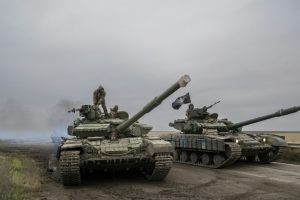
ISW Russian Offensive Campaign Assessment, November 18 – Kyiv Post
Key Takeaways
- Russian officials are preparing for further covert mobilization efforts even as the fall conscription cycle is underway, likely further diminishing the development of quality mobilized and conscripted servicemen.
- The International Atomic Energy Agency (IAEA) announced that it does not recognize the illegal Russian seizure of the Zaporizhzhia Nuclear Power Plant (ZNPP) or the illegal annexation of other occupied Ukrainian territory, a sharp escalation in IAEA rhetoric.
- Social media footage circulated on November 18 shows a Russian soldier opening fire on Ukrainians as other Russian soldiers were surrendering.
- Russian forces reinforced rear areas in Luhansk Oblast and attempted to regain lost positions as Ukrainian troops continued counteroffensive operations along the Svatove-Kreminna line.
- Russian forces continued limited ground assaults near Bakhmut and Avdiivka and in western Donetsk Oblast.
- Russian occupation officials and military leadership are seemingly increasingly concerned about subsequent Ukrainian counteroffensive operations in southern Ukraine.
- Russia continues to face exceedingly low morale and poor discipline among its forces against the backdrop of ongoing domestic backlash to partial mobilization.
- Russian occupation officials and forces continued to intensify filtration measures in Russian-occupied territories in Ukraine and to undermine the Ukrainian national identity.
Russian officials are preparing for further covert mobilization efforts even as the fall conscription cycle is underway, likely further flooding the already overburdened Russian force generation apparatus in such a way that will be detrimental to the development of mobilized and conscripted servicemen. Russian Telegram channels actively discussed indicators on November 18 that the Kremlin is preparing for a second mobilization wave and circulated an image of a draft summons received by a citizen of St. Petersburg who was reportedly told to appear for mobilization in January 2023 despite Russian President Vladimir Putin’s announcement of the formal end of partial mobilization on October 31.[1] Nationalist milbloggers additionally circulated claims that general mobilization will begin in December or January.[2] An independent Russian outlet published an investigation on November 18 showing that state structures and enterprises are continuing to prepare their employees for mobilization by sending them to various training programs and mobilization-related educational courses.[3] Another Russian outlet noted that the Odintsovo garrison military court in Moscow Oblast inadvertently confirmed that mobilization is continuing despite its formal end.[4] The court reportedly accused a mobilized soldier of beating his commander on November 13 “during the performance of his duties of military service or in connection with the performance of these duties during the period of mobilization,” which indicates that the court is operating on the legal basis that mobilization is still very much underway.[5] The Kremlin has said that Russian President Vladimir Putin has no need to sign a decree formally ending the mobilization period, as ISW has previously reported.[6]
The continuation of covert mobilization efforts and potential preparations for another mobilization wave in tandem with the current fall conscription cycle are likely adding substantial strain to an already over-burdened Russian force generation apparatus. As ISW previously assessed, Putin likely ordered the end of partial mobilization in order to free up bureaucratic and administrative capacity for the November 1 conscription class.[7] However, it is evident that Russian authorities never fully halted mobilization efforts, which means that a limited number of mobilized recruits are still being forced through the training system at the same time as conscripts are going through their own training cycle. This will likely lead to even lower quality training for both mobilized recruits and conscripts as they compete for insufficient training capacity. Another wave of mobilization in the coming months will only worsen the situation and likely degrade the overall quality of the Russian troops that will be funneled to the frontline in Ukraine.
The International Atomic Energy Agency (IAEA) announced that it does not recognize the illegal Russian seizure and operation of the Zaporizhzhia Nuclear Power Plant (ZNPP) or the illegal annexation of occupied Ukrainian territory, a sharp escalation in IAEA rhetoric. The IAEA’s Board of Governors issued a statement on November 17 that called on Russia to “immediately abandon its baseless claims of ownership of the plant” and to withdraw “military and other personnel” from the ZNPP due to “grave concerns” over the ZNPP’s integrity.[8] The IAEA issued a statement on November 18 that Russian strikes on November 17 partially or completely cut power to Ukraine’s Khmelnytskyy Nuclear Power Plant and Rivne Nuclear Power Plant, and IAEA Director-General Rafael Grossi stated that these strikes demonstrate “the potential nuclear safety and security risks facing all of Ukraine’s nuclear facilities during this terrible war, not just the Zaporizhzhia Nuclear Power Plant.”[9] ISW recently assessed that the IAEA’s rhetorical shift suggests that Russian physical control and operational authority over the ZNPP alarms the IAEA.[10] Russian forces’ ongoing threats to both the ZNPP and Ukrainian nuclear power plants (NPPs) in unoccupied territory indicate that Russia is an unsuitable caretaker of the ZNPP, even though the Russian government relies on claims that it is a responsible operator of the ZNPP to legitimize its ongoing presence at the plant.[11]
Social media footage circulated on November 18 shows a Russian soldier opening fire on Ukrainians as other Russian soldiers were surrendering. The graphic footage shows Ukrainian troops in Makiivka, Luhansk Oblast, taking a group of Russian soldiers prisoner when one Russian soldier emerges from a house holding a gun and opens fire.[12] Drone footage shows the bodies of the deceased Russian soldiers after the incident.[13] Open-source analysts concluded that the Russian soldier opened fire initially, but it is unclear who killed the Russian prisoners, when, and under what circumstances.[14] However, the Russian information space immediately responded to the footage by widely accusing Ukrainian forces of a ”mass execution” of the Russian prisoners.[15] The Russian Investigative Committee opened a criminal case against Ukrainian Armed Forces and is reportedly trying to identify the Ukrainian servicemen in the video.[16]
See the full report here.


Average Rating